Resources
If you don't really understand the content of the primary mathematics curriculum, how can you teach it? This book shows you how to explore number, shape and pattern with the children you...

Pipkin the smallest penguin is always asking questions, but what he wants to know most of all is how big is a million. So he sets off to find out, and along the way meets 100 penguins, sees 1,000 snowflakes and meets...

This series uses child friendly points of reference to explore scientific and mathematical measurements.
The books present numerical data in a visual way that makes it easier to comprehend.
Each book...
How Big Is the Universe?
It is almost impossible for the human mind to grasp just how big the universe is, but astronomer Pete Edwards gives it his best shot in this Teaching Astronomy and Space video from the Institute of Physics (IOP), Teachers TV and Science and Technology Facilities...
This item is one of over 25,000 physical resources available from the Resources Collection. The Archive Collection covers over 50 years of curriculum development in the STEM subjects. The Contemporary Collection includes all the latest publications from UK educational publishers.
How bras inspired the spacesuit
Dallas Campbell talks about how bras require engineering design to enable them to be both comfortable and supportive. He explains how a bra manufacturer was involved in the first designs of space suits for NASA.
An entertaining and informative collection of great brain tricks, experiments, puzzles, quizzes, and activities provides kids a cool road map to exploring the most awesome part of the body, showing how the brain, nerves, and senses work.
How Can Atoms Exist?
Alice wonders how a tree can exist and therefore how atoms can exist. Bob suggest that in an atom, electrons orbit the nucleus of an atom like a planet orbits the Sun. Alice explains that if that the charged electron should give off light and lost energy and spiral into the nucleus. That leads them on to...
Defines wheels, explains their functions, and suggests simple experiments to demonstrate how they work.
This item is one of over 25,000 physical resources available from the Resources Collection. The Archive Collection covers over 50 years of curriculum development in the STEM subjects. The Contemporary Collection includes all the latest publications from UK educational publishers.
